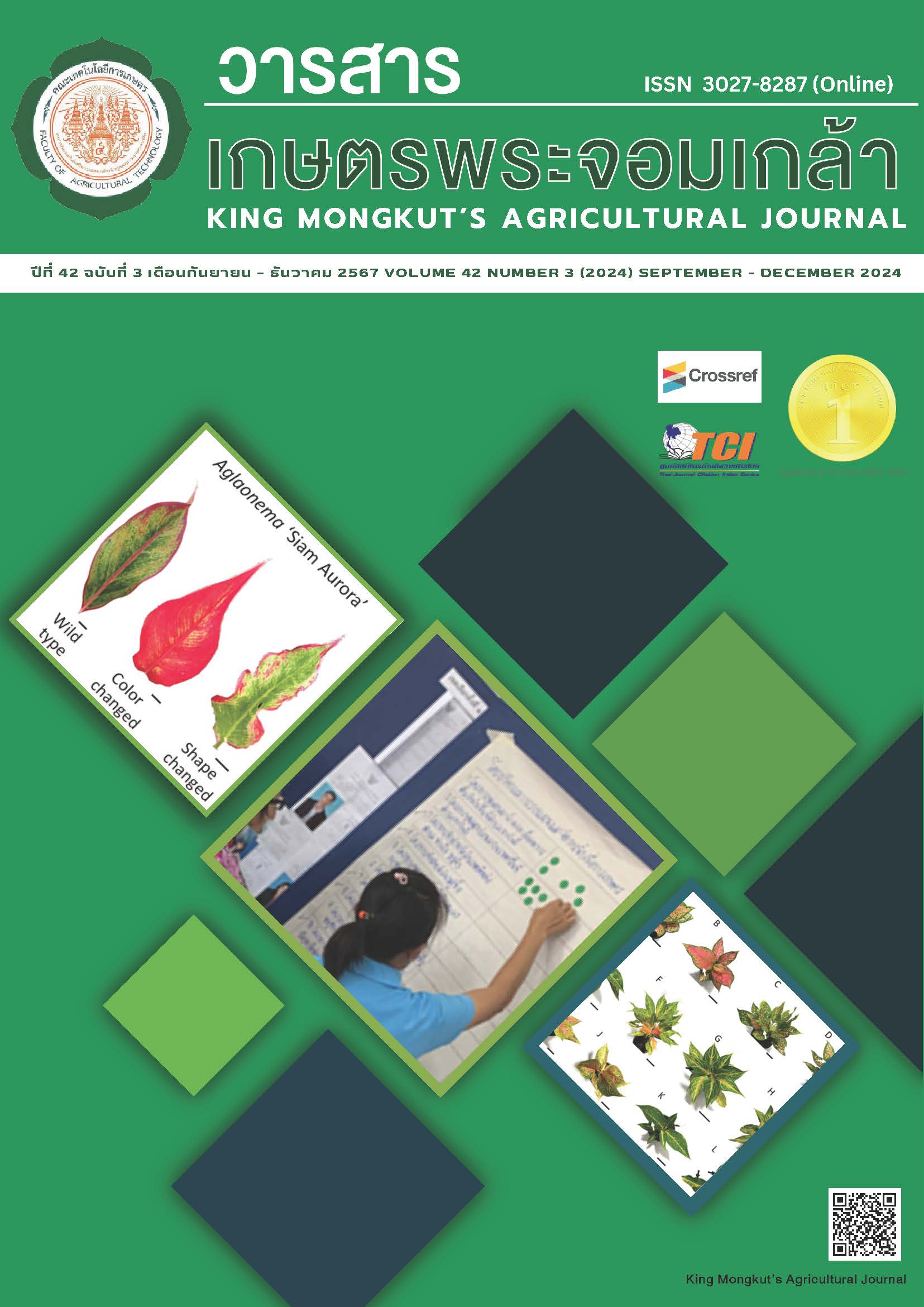การใช้แพลงก์ตอนพืชชนิดเด่นในการประเมินคุณภาพแหล่งน้ำ: กรณีศึกษาแหล่งน้ำมหาวิทยาลัยเกษตรศาสตร์ เขตจตุจักร กรุงเทพมหานคร
Main Article Content
บทคัดย่อ
งานวิจัยนี้เป็นการศึกษาการใช้แพลงก์ตอนพืชชนิดเด่นเป็นตัวบ่งชี้คุณภาพแหล่งน้ำจากการเก็บตัวอย่างจำนวน 6 สถานี (S1-S6) ผลการศึกษาพบแพลงก์ตอนพืชทั้งหมด 6 ดิวิชัน 34 สกุล ได้แก่ ดิวิชัน Euglenophyta, Chlorophyta, Bacillariophyta, Chromophyta และ Pyrrhophyta แพลงก์ตอนพืชสกุลเด่นที่พบ ได้แก่ Euglena, Phacus และ Tetraedron โดยการวิเคราะห์หาค่าคะแนนสำหรับการประเมินคุณภาพน้ำด้วย AARL-PP Score โดยใช้แพลงก์ตอนสกุลเด่น 3 สกุล ผลการประเมินพบว่า จุดเก็บตัวอย่าง S1-S4 คุณภาพน้ำส่วนใหญ่อยู่ในระดับปานกลาง และจุดเก็บตัวอย่าง S5-S6 คุณภาพน้ำอยู่ในระดับปานกลางถึงไม่ดี ค่อนข้างสกปรก สำหรับการวิเคราะห์ทางสถิติในการศึกษาถึงความสัมพันธ์ระหว่างแพลงก์ตอนพืชชนิดเด่นกับคุณภาพน้ำโดยวิธีการถดถอยพหุคูณแบบขั้นตอน พบแพลงก์ตอนพืช ดิวิชันเด่นที่สุดคือ ดิวิชัน Cyanophyta (สาหร่ายสีเขียวแกมน้ำเงิน) ซึ่งพบสกุลเด่น คือ Merismopedia มีค่าความสัมพันธ์กับค่าความโปร่งแสง ค่าความเค็ม ปริมาณคลอโรฟิลล์เอ และปริมาณฟอสเฟตละลายน้ำ และสกุล Oscillatoria มีค่าความสัมพันธ์กับปริมาณของแข็งแขวนลอยทั้งหมด ปริมาณคลอโรฟิลล์เอ ความโปร่งแสง ค่าความเป็นกรด-ด่าง อุณหภูมิ และปริมาณแอมโมเนียม–ไนโตรเจน ซึ่งความสัมพันธ์บ่งชี้ถึงความเหมาะสมการเจริญเติบโตของแพลงก์ตอนพืชได้รวดเร็วจากคุณภาพน้ำที่ลดลง เมื่อพิจารณาคุณภาพน้ำตามมาตรฐานคุณภาพน้ำในแหล่งน้ำผิวดินสามารถจัดคุณภาพน้ำอยู่ในประเภทที่ 3
Article Details

อนุญาตภายใต้เงื่อนไข Creative Commons Attribution-NonCommercial-NoDerivatives 4.0 International License.
วารสารเกษตรพระจอมเกล้า
เอกสารอ้างอิง
Burford, M. A., & Rothlisberg, P. C. (1999). Factors Limiting Phytoplankton Production in a Tropical Continental Shelf Ecosystem. Estuarine, Coastal and Shelf Science, 48(5), 541–549.
Cha-umphol, P. (1996). Relation Between Phytoplankton and Some Nutrients in Huay Tung Tao Reservoir. Master’s Thesis. Chiang Mai University. (in Thai).
Fried, S., Mackie, B., & Nothwehr E. (2003). Nitrate and Phosphate Levels Positively Affect the Growth of Algae Species Found in Perry Pond. Grinnell College, 4, 21-24.
Gajaseni, N. (2001). Manual of Freshwater Ecology Laboratory. Chulalongkorn University. (in Thai).
Horaban, T. (1998). Relationships Between Water Quality and Phytoplankton in the Bangpakong River. Kasetsart University. (in Thai).
Kaewrungfah, W., Sangmala, S., & Wongpanya, I. (2020). The Water Quality and Diversity of Phytoplankton in Huai Thap Chang, Reservior University of Phayao. Bachelor’s Degree. University of Phayao. (in Thai).
Mahidol University. (2013). Phosphate Field Test Kit. Retrieved from: http://www.sc.mahidol.ac.th/tha/research/webtestkit/phosphate.htm. (in Thai).
Patrick, R. (1977). Ecology of Freshwater Diatoms-Diatoms Communities. The Biology of Diatom, 284-332. (in Thai).
Peerapormpisal, Y. (2015). Freshwater Algae in Thailand. Chotana Print. (in Thai).
Peerapormpisal, Y., Pekkoh, J., Powangprasit, D., Tonkhamdee, T., Hongsirichat, A., & Kunpradid, T. (2007). Assessment of Water Quality in Standing Water by Using Dominant Phytoplankton (AARL- PP Score). Journal of Fisheries Technology Research, 1(1), 71-81. (in Thai).
Rattanaphani, W., Liawruangrath, S., & Rattanaphani, S. (1990). Water Quality Research and Analysis from Mae Ping Water Resources. Chiang Mai University. (in Thai).
Reynolds, C. S. (1984). The Ecology of Freshwater Phytoplankton. Cambridge University Press.
Sakset, A., & Chankaew, W. (2013). Phytoplankton as a Bio-Indicator of Water Quality in the Freshwater Fishing Area of Pak Phanang River Basin (Southern Thailand). Chiang Mai Journal Science, 40(3), 344-355. (in Thai).
Sitthikanjanakul. S., & Wanpensakul. J. (2017). Using Dominant Phytoplankton as a Bioindicator of Water Quality in Naruebodindrachinta Reservoir, Prachinburi Province. Bureau of Research and Development, Royal Irrigation Department. (in Thai).
Smith, B., & Wilson, J. B. (1996). A Consumer’s Guide to Evenness Indices. Oikos, 76, 70-82.
Strickland, J. D. H., & Parsons, T. R. (1972). A Practical Handbook of Seawater Analysis. Fisheries Research Board of Canada.
Sunpapao, P., Ponza, S., Pongpadung, P., & Tawong, W. (2017). Species Diversity of Phytoplankton and Relationship with Water Quality in Mae Thang Reservoir, Phrae Province. Khon Kaen Agriculture Journal, 45(4), 663-674. (in Thai).
Vasistha, P., & Ganguly, R. (2020). Water Quality Assessment of Natural Lakes and Its Importance: An Overview. Materials Today: Proceedings, 32(4), 544-552.
Thomas, M. K., Aranguren‐Gassis, M., Kremer, C. T., Gould, M. R., Anderson, K., Klausmeier, C. A., & Litchman, E. (2017). Temperature–Nutrient Interactions Exacerbate Sensitivity to Warming in Phytoplankton. Global Change Biology, 23(8), 3269-3280.
Weeraphong. M., Ramasoot. S., & Jaihowweerapong. D. (2023). Algae Diversity as Water Quality Indicator in the Main Water Sources, Nakhon Si Thammarat. King Mongkut's Agricultural Journal, 41(1), 70-80. (in Thai).
Wongrat, L. (1999). Phytoplankton. Kasetsart University. (in Thai).
Wongrat, L., & Boonyapiwat, S. (2003). Manual of Sampling and Analytical Methods of Plankton. Kasetsart University. (in Thai).
Yimyon, S. (2018). Bioindicators for Indicating Quality of Freshwater Ecosystem. KKU Science Journal, 46(3), 408-417. (in Thai).


